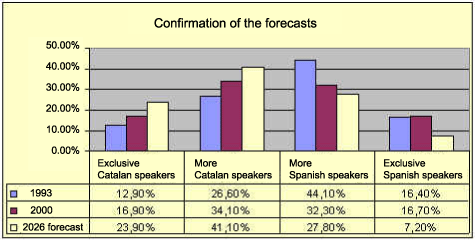The real group is all the bar of the same colour. For example, in table 9, the
exclusive Spanish speaking group is delimited correctly in a 79% of the cases, only a 2%
of pupils "more Spanish speaking" are included (the little yellow band of the
base).
Otherwise a 21% is
incorrectly situated in the bar of "more Spanish speakers" (the blue band).
4.3.2. The evolution forecasts of linguistic groups since 1993
The reference
group (or willed linguistic group) plays an essential predictive paper upon the
fulfilled predictions of 1993. We proposed this variable as a fact to preview the
evolution of the composition from the established linguistic group. We remarked that the
willed group in 1993 could be the real use after a generation (33 years). Let us see it in
the following table:
Table 11. The
confirmation of the forecasts

With the details of
1993 we knew the composition of four linguistic groups, (the first horizontal line of the
table: 12.90%, 26,60%, 44.10% and 16.40%) and the groups were the pupils wanted to be (the
third horizontal line of the table: 23.90%, 41.10%, 27.80% and 7.20%). With the details
that we have just obtained (second horizontal line) we noticed that the three groups
follow the forecasts that we made in the research of 1993: Both groups of Catalan speakers
increase and the ones that speak more Spanish, decrease. Therefore the Spanish speakers
group takes the contrary way of the predictions, and increases in 0.30%. Fact that is not
very significant because the other evolutions are of 4%, 7.50% and 11.80%, all of them in
the direction that we indicated.
The details obtained
in year 2000, even allows us to shorten the period of 33 years, because what we affirm has
already been completed in a 36.36%, in a 51.72% and in a 71.08%. Except in the exclusive
Spanish speaker group that has taken this slight tendency opposed to the forecasts.
5.
Conclusions
The objectives that
we concrete in point 2, have been completed in excess. The first, was to know the
evolution of the uses of Catalan in the seven years that go form 1993 to 2000; in the
point 4.1 we have seen them clearly. In second place, we wanted to know if the variables
that favourite the use of Catalan changed or not, and we noticed that they have not done
in a substantial way (point 4.2). In third place, we have checked if the forecasts made
eight years ago have been completed in a very high way. And, finally, we have corroborated
our theoretical proposal for third time (1193, 1998 and 2000).
Therefore the
dominant theories did not arrive to explain even the 10% of the characteristics from the
language, with our own theoretical and methodical point of view, we have obtained a 75% of
justification of these linguistic characteristics. But not only this. We’ve been
further on to the level of co-variation, we’ve used instruments of multivariable
analysis, like the multiply regression and the induction techniques by graphs (SIPINA),
also the discriminate analysis; that has allowed us, between other things, to prove the
predictive capacity of our model, that reaches 83.8% of the classified cases.
We can ask ourselves
why have we obtained these results. A very easy answer would be that we have passed from a
mono-casual diagram (or attitude or motivation or identity…) to a conception that
articulates three principal variables, and also includes the facts that pretended to
explain the three of them separately; like the attitude ones, that form part of our theory
of social representations, that we purposed as a frame of our conception.
By other way, we
have improved in the classifications and we have divided the contexts of linguistic
replacement in four groups of speakers: two that are nearer from the mono-linguistic and
two bilinguals, with a priority language in each case. Said in a different way, we have
justified the dependent variable (linguistic use) with the interaction of the independent
variables: the representation of the reference group, the representation of languages and
the representation of social nets.
Finally, the
recourse to the catastrophe theory has allowed us to realise our discursive reflection of
agreement, not only with the empirical rules, but as well to a minimal formal system,
thing that means that the proposed model has a great coherence: As theoretical as formal,
and we corroborate it, again, empirically with the investigation done in year 2000. |
